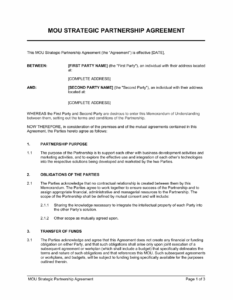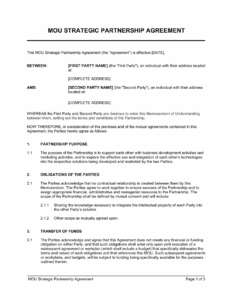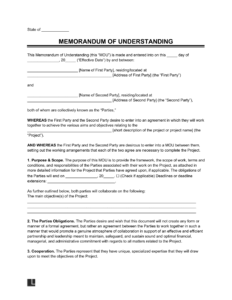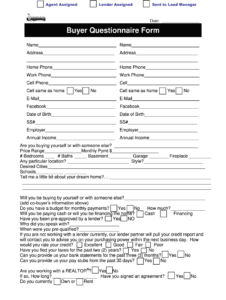Venturing into any new investment opportunity, whether it’s a startup, real estate, or a joint venture, often begins with a series of crucial conversations and shared understandings. Before diving into complex legal documents, many parties find immense value in outlining their intentions and expectations in a simpler, yet structured, way. This is precisely where a Memorandum of Understanding (MOU) comes into play, serving as a foundational document that sets the stage for more formal agreements to follow.
An MOU isn’t legally binding in the same way a contract is, but it provides a clear roadmap, minimizing misunderstandings and ensuring everyone is on the same page regarding the core elements of a potential deal. For those exploring investment opportunities, having a reliable memorandum of understanding investment template at hand can significantly streamline the initial negotiation process, allowing all parties to articulate their vision and commitment without getting bogged down in intricate legal jargon from the outset.
Navigating the Essential Elements of an Investment MOU
When you’re looking to establish a preliminary understanding for an investment, a well-structured MOU is your best friend. It acts as a compass, guiding all involved parties through the initial phases of collaboration, ensuring that fundamental expectations are clearly laid out. Think of it as a handshake on paper, detailing the spirit of the agreement and the proposed terms before anyone commits to a binding contract. While non-binding, its importance lies in its ability to clarify intentions, responsibilities, and the scope of the investment.
Crafting this document effectively means including several key sections that address the critical aspects of the potential investment. It outlines who is involved, what the investment entails, and the shared objectives. It’s about building a framework for future discussions, making sure no stone is left unturned regarding the preliminary agreement. This initial clarity can save a lot of time and potential disputes down the line, fostering trust and a cooperative environment for all participants.
Identifying the Key Players
Every investment involves parties with distinct roles and contributions. The MOU should clearly identify all individuals or entities involved in the investment, including their full legal names, addresses, and any relevant contact information. This ensures that there’s no ambiguity about who is participating in the proposed venture.
Laying Out the Investment Scope
This section is crucial for detailing the core of the proposed investment. It should clearly describe the nature of the investment, the amount of capital or assets to be contributed by each party, the proposed use of funds, and the overall objectives that the investment aims to achieve. Being specific here helps align everyone’s expectations from the very beginning.
Confidentiality and Exclusivity
- Confidentiality: Often, initial investment discussions involve sharing sensitive financial or proprietary information. An MOU typically includes a confidentiality clause, obligating all parties to keep shared information private and use it only for the purposes of the proposed investment.
- Exclusivity: Depending on the situation, parties might agree to an exclusivity period during which they will negotiate solely with each other, refraining from entertaining similar offers from third parties. This commitment can demonstrate serious intent and help focus negotiations.
Beyond these, a good MOU will also touch upon aspects like the proposed timeline for due diligence, the conditions under which the investment might proceed (or be terminated), and the governing law that would apply to the interpretation of the MOU. While these elements are non-binding, they provide a strong indication of how the parties intend to move forward and what benchmarks they expect to meet.
Ultimately, a well-considered MOU for investment purposes is a testament to thoughtful planning and a shared vision. It acts as a critical precursor, ensuring that when the time comes for a legally binding contract, many of the core understandings are already solidified, making the transition smoother and more efficient for everyone involved.
Why a Memorandum of Understanding Investment Template is Your Best Starting Point
Embarking on any investment journey can be complex, involving numerous details and careful considerations. This is precisely why utilizing a memorandum of understanding investment template can be incredibly advantageous. It offers a structured beginning, ensuring that all fundamental aspects of a potential deal are considered and discussed right from the outset. Instead of staring at a blank page or missing crucial points, a template provides a comprehensive framework that prompts you to address every necessary component, saving both time and potential headaches down the road.
A pre-designed template significantly reduces the effort involved in drafting an MOU from scratch. It acts as a comprehensive checklist, guiding you through sections you might otherwise overlook, such as dispute resolution mechanisms or conditions for termination. This structured approach helps ensure clarity and thoroughness, minimizing ambiguities that could lead to misunderstandings later. Furthermore, it sets a professional tone for all preliminary discussions, demonstrating that all parties are serious about formalizing their intentions and working towards a successful outcome.
- Streamlines initial discussions and negotiations.
- Ensures all critical aspects and preliminary terms are considered.
- Provides a professional and consistent framework for all parties.
- Reduces the need for extensive legal input during the very early stages.
- Helps identify potential sticking points early, allowing for proactive resolution.
While a memorandum of understanding investment template is an excellent tool for laying the groundwork, it’s vital to remember that it’s a preliminary document. It’s designed to capture the essence of your mutual intent and facilitate further detailed negotiations. Always treat it as a stepping stone towards a final, legally binding agreement, and never hesitate to seek professional legal advice before signing any definitive contracts. This approach ensures your investment is well-protected and aligned with your long-term goals.
The careful construction of an MOU for investment purposes is an invaluable step in any significant venture. It fosters a clear, transparent environment for all parties, building a foundation of trust and shared understanding. By thoroughly outlining intentions and expectations, you pave the way for more efficient negotiations and ultimately, a more successful and harmonious partnership.
Embracing this methodical approach ensures that your initial discussions are productive and purposeful, setting a positive trajectory for the entire investment lifecycle. It’s about being prepared, being precise, and ensuring that every stakeholder is aligned from the very beginning, leading to stronger agreements and more prosperous outcomes.



